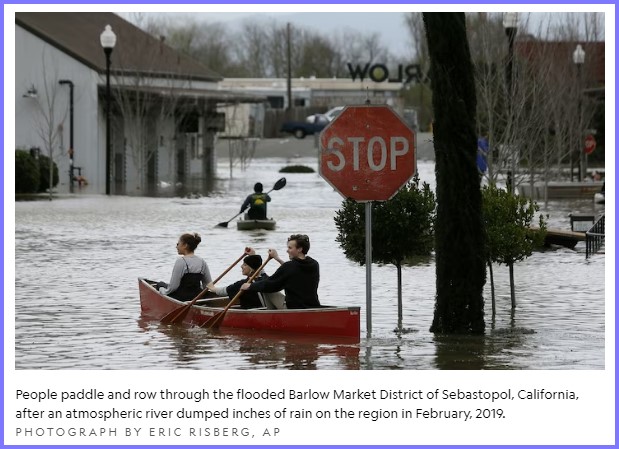The newest registered user is гераскинс
Our users have posted a total of 48009 messages in 7050 subjects

WORLD CLOCK
NAT GEO * ‘Rivers in the sky’: Why California keeps flooding *
Valley of the Sun Casual Club :: WORDS , FACTS , DATES , GAMES & TRIVIA & HISTORY :: NATIONAL GEOGRAPHIC
 NAT GEO * ‘Rivers in the sky’: Why California keeps flooding *
NAT GEO * ‘Rivers in the sky’: Why California keeps flooding *

[size=38]How atmospheric rivers cause flooding
Atmospheric rivers move huge amounts of water through the air above us—and dump rain and snow on land.
BYALEJANDRA BORUNDA
PUBLISHED JANUARY 25, 2024
• 6 MIN READ
[/size]
In the coming weeks, buckets of rain are likely to batter California. The culprit? Atmospheric rivers.
The rains are born far away, deep in the tropical Pacific, where water evaporated from the warm ocean surface is absorbed into the atmosphere. These drenched parcels of air parcel flow sinuously along, an “atmospheric river” winding its way toward land. When that wet air hit a coast—in this case the West Coast of the United States—it unleashed torrents of water.
What is an atmospheric river?
“You need two ingredients for an atmospheric river,” says Daniel Swain, a climate scientist at the University of California, Los Angeles. “A plume of really concentrated moisture in the atmosphere and strong, fast winds to move it around.”
The concentrated moisture comes from the ocean. Warm oceans evaporate water into the atmosphere, and winds and storms concentrate that water vapor into long, narrow, speedy trains of extra-wet air. Then, big global winds in the lower few miles of the atmosphere accelerate those amped-up, stretched-out, water-rich versions of normal storms.
The sky-borne rivers can stretch for thousands of miles. In 2017, an enormous atmospheric river 5,000 miles long slammed into the Pacific Northwest, dumping over two inches of rain on the region over a few days. Most aren't that massive, though—the average atmospheric river is about 500 miles wide and 1,200 miles long.
They transport huge volumes of water around the world, carrying it along as vapor and cloud droplets. In an average atmospheric river, about 25 times as much water flows through the air high overhead as through the Mississippi River—and on any given day, about three or four are either developing or flowing through the sky in each hemisphere.
“In a way, they're actually the biggest rivers on earth,” says Marty Ralph, a researcher at the Scripps Institution of Oceanography in La Jolla, California, who been studying the phenomena for years. “They're just in the air instead of on the ground.”
All in all, more than 90 percent of the water that gets moved around Earth's midlatitudes—its midsection, where most of the world's population lives—gets transported via these sinuous sky streams. "They play this really key role in bringing moist tropical and subtropical air into the drier mid-latitudes," says Nina Oakley, an atmospheric scientist at the Desert Research Institute in Reno.
Atmospheric rivers are everywhere: They've dumped record-breaking snow on East Antarctica, driven flooding in Europe, and caused rivers to spill their banks in Australia. Particularly strong ones can hold together and cross the entire North American continent, dumping snow and rain all the way from the West Coast to the East. Gulf of Mexico- and Atlantic-brewed atmospheric rivers often feed into heavy rain and snow of winter nor'easters across the eastern U.S.
Some atmospheric river pathways are so well-known that they have their own affectionate names. The "Pineapple Express," for example, speeds tropical Pacific moisture from around Hawaii toward the West Coast of the U.S.
The damp sponge effect
The water vapor locked up in an atmospheric river will stay just that—vapor—until something comes along to squeeze it out of the air as rain or snow. Often, that trigger is the edge of a continent: along the west coast of North and South America, for instance, atmospheric rivers crash into mountains, which forces the sodden air masses higher into the atmosphere. As they get forced upward into colder air, the water vapor gets squeezed out—and falls out of the sky as rain or snow. Any cold air can trigger that squeeze-out, though.
“These saturated plumes of air are like a damp sponge,” says Swain, “and a mountain range or a storm system is like a hand wringing that sponge out.”
California gets somewhere between 25 to 50 percent of all its annual precipitation from atmospheric rivers. Often, that's good news—the events have ended droughts, refilled reservoirs, and greened rolling hills. When the precipitation falls as snow in the high mountains, it acts as a kind of long-term water storage system, melting in the spring and summer when the state is parched. But when it comes down as rain, the effects can be devastating, causing floods, mudslides, dam breaches, and more.
The kinds of extreme, destructive rain events that have made news in California over the past few years are not alone: atmospheric rivers are at play in up to half of the most intense, extreme rain storms experienced across the planet.
In February 2019, a group of researchers introduced a new system to classify the strength of these atmospheric rivers, sort of like the way hurricanes are categorized with the Safford-Simpson scale. The scale looks at how much water the air moves around over time—the “Integrated water vapor transport,” or IVT, measures how much water vapor flows past a point at any given time—and the scale also takes into account how long the river stalls out on top of a place. Then, it assigns the river a number from zero (not an atmospheric river) to five (a very, very wet one). The most recent deluge in Northern California, says Ralph, was somewhere between a three and a four on the scale where the worst of the flooding took place, near the Russian River.
Atmospheric rivers and the warming climate
Air temperatures have ticked upward by about 1 degree Celsius, or about 2 degrees Fahrenheit, over the last century—and they're expected to rise by more than that by the end of the century. With warmer air comes wetter air: toastier temperatures evaporate more water from the ocean. On top of that, air can hold about seven percent more water vapor for each degree warmer it gets. So scientists expect that in a hotter future, atmospheric rivers will get correspondingly wetter and stronger.
 Similar topics
Similar topics» INSPIRING QUOTES The Iconic Wit of Joan Rivers
» A LOOK AT FAMINE IN THE US
» A LOOK AT US FEAST
Valley of the Sun Casual Club :: WORDS , FACTS , DATES , GAMES & TRIVIA & HISTORY :: NATIONAL GEOGRAPHIC

 Events
Events















































































» INTRO TO WORD SMARTS
» PINTEREST ICONIC COMIX
» HISTORY FACTS * Gold wasn't always the top Olympic medal *
» Word Genius Word of the day * occlude *
» JULY NATIONAL CELEBRATION DAYS JULY 26 2024
» QUIZ TREAT QUIZ *Which mammal has the most powerful bite? *
» QUIZ TREAT ANSWER PAGE
» NAT GEO * The 2024 Olympics will likely be the hottest ever *
» NAT GEO * Sharks found with cocaine in their systems *
» WISE TRIVIA QUIZ *What was the first song ever played on the radio? *
» WISE TRIVIA ANSWER PAGE
» E.S.Etaski * Sister Seekers Book 10 now available everywhere! *
» WORD DAILY Word of the Day: * literatim *
» JULY NATIONAL CELEBRATION DAYS JULY 25 2024